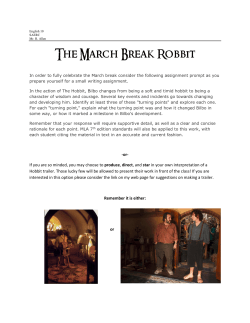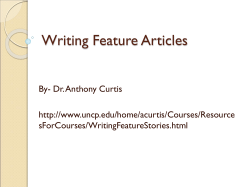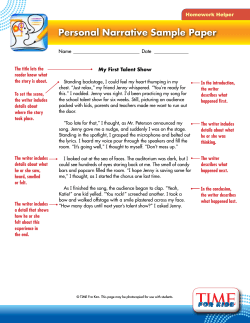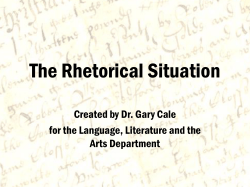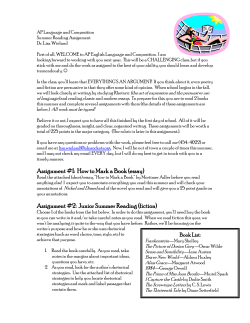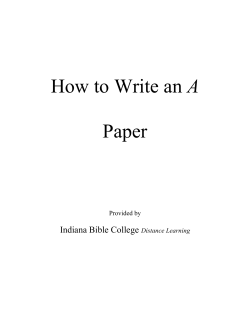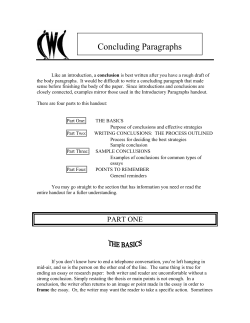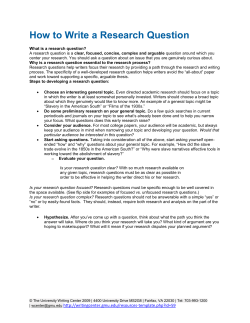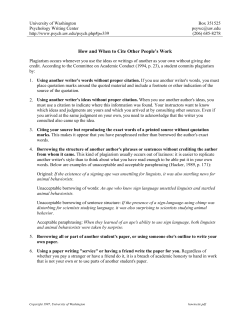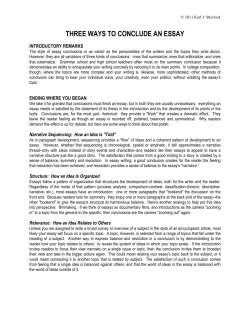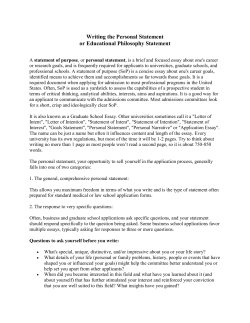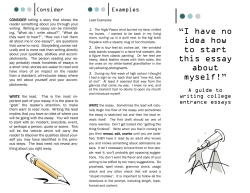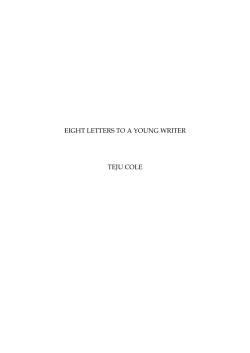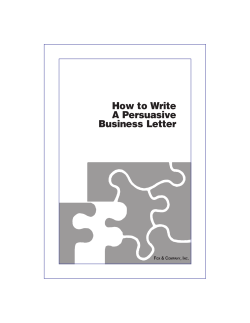
Writing a Critical or Rhetorical Analysis
The Writing Lab – D204d http://bellevuecollege.edu/asc/writing 425-564-2200 Writing a Critical or Rhetorical Analysis What is a Critical (or Rhetorical) Analysis? A critical analysis is an essay that evaluates another piece of writing. It uses critical thinking to assess the strengths and/or the weaknesses of a piece of writing and tells the readers how well or how poorly the original writer communicated his/her point or points. Whether you agree with the piece or not is unimportant; you must remain objective while evaluating the writer’s style and effectiveness. Evaluate the Essay Instead of the Original Topic If the original essay was about crime, then your paper is not about crime. Instead, write on how well the author discusses the topic of crime. You are writing about a piece of writing, not the original topic that was addressed. Use Summary ONLY as Supporting Evidence Unless the assignment asks for a summary, assume that your readers have already read the piece at some point. You can use short summaries as supporting evidence for your analysis, but avoid retelling or describing everything the author says. Cover Only the Most Important Topics Mentioning every point from the original essay makes it very easy to lapse into summarizing. Choose a few “big” topics that you can discuss in detail and focus on them. Avoid “I” Statements Avoid using “I” statements because “I” statements draw attention to yourself and take focus away from the piece you are analyzing. If you decided the piece was effective or not, you probably have good reasons. Focus on those reasons—the strengths or weaknesses of the paper—then your analysis will be strong enough that you will not need an “I” statement to explain your opinion. Keep Your Voice Distinct: They Say, I Say There will be two “voices” in your paper: the original author’s and your own. To avoid confusing the author’s voice with yours, use phrases like “the author says,” “the author thinks,” and “the article states that” when referring to the original author’s opinions. Then follow up with your analysis, but again, avoid using “I” phrases. Remember to Cite Your Sources Use proper quotations, in-text citations, and a works cited page at the end. MLA style is the usual format, but your instructor may prefer APA or Chicago style. Check to make sure. What Topics May Be Covered? The following are some topics and questions to ask yourself while brainstorming. It is not necessary to write about ALL of them—some of these topics may not apply to your paper, and some topics may overlap. When drafting your paper, order these topics in a way that makes sense to you and flows well. Theme or Topic Do not comment on the theme or topic itself, but discuss how well the writer addresses or approaches the theme. Does the argument shed new light on the theme? Could the author have done a better job portraying the theme? Organization Are the author’s arguments presented in a clear, well-thought out manner? Is it easy to follow his/her thought process? Or does the essay jump around and feel jumbled? Audience Was the essay written for a specific set of people, such as those who work in a particular profession or share a common interest? Does the writer assume the audience has prior knowledge of the subject and background material? Or does the writer assume the audience is naïve and uninformed? Perhaps the topic is controversial and the writer is assuming the audience disagrees with his/her opinion. Tone When reading the original work, does it feel like listening to a lecture or listening to a conversation? Does the writer seem to be speaking as an individual or as part of a group? Does the writer express emotion, such as anger or enthusiasm, for the topic? Most of all, how does the tone affect the writing? Does it help or hurt the writing? Bias or Missing Information Does the writer approach the topic objectively? Has s/he looked at it from many angles before expressing a viewpoint? Or is the writer’s opinion voiced so strongly that it ignores contradicting viewpoints? Is there any missing information? Did the author leave out important information? 2 Word Choice Is the writing serious or silly? Casual or technical? Formal or informal? Does the author use slang or colloquial language? Does s/he invent new words or phrases to define new concepts? Does the author use words that only his/her specific audience would understand, or does s/he write so that anyone can understand and relate? How does the word choice affect the author’s overall writing? Does it make the piece accessible or annoying? What would be the effect if other words had been used? Logos, Ethos, and Pathos This is a mixture of both tone and word choice. Greek philosophers divided the methods of persuasion into these three categories. If the author is trying to convince readers of a particular point, which of these are used? Logos (logic) Does the writer use logical reasoning to make his/her point? What are some examples from the original text? Ethos (credibility) Pathos (emotion) Does the writer claim to be an expert on the subject? What proof does s/he give for his/her credibility? How does the writer gain the audience’s trust and respect so they believe what is being said? Perhaps the writer does not make any claim, but shows through examples and research that their words are valid. Does the writer try to invoke an emotional response from the audience? Does s/he use personal stories to emphasize his/her point? Does s/he appeal to common beliefs and values to persuade the audience? Does the writer try to get the audience to see things from his/her own point of view? Do they use emotional language, vivid language and/or descriptive imagery? • If the analysis is for a piece of creative writing, some additional topics may include rhythm, rhyme scheme, imagery, and mood. • If the analysis is for a movie or film, additional topics may include lighting, use of music and sound, the quality of acting, special effects, story layout and plot sequencing, and camera angles. 3 Critical Analysis of Style Example Sarcasm Anyone? Spiro T. Agnew's essay “English Anyone?” attempts to spread the author's disgust about recent changes in the English language: grammatical errors, the elimination of words that discriminate against women, and the careless use of language. In the beginning of his essay, he states his point solidly and simply, and unemotionally presents an example of an incorrect practice. But gradually, Agnew reveals his disgust for misuses of language, and this aggressive emotion increases as the essay develops. Agnew tries to convince the reader through sarcasm and by using commanding words like “should.” He also clearly shows what he considers to be a black and white issue and requires the reader to choose either black or white. Eventually his argument collapses from its own offensive tone. Agnew uses the word “should” in every paragraph to show his adamant stand on the issue. For example, he writes “should not be used” (410), “should amend” (410), and “should express” (411). He also uses strong words in rhetorical questions: “Why must we . . . ?” (410). By using these forceful words, he creates a rigid tone that makes the reader feel intimidated. In addition, the word “indisputable” (410) limits the reader's responses, and implies that there is no way to accept changes in the language. Agnew also emphasizes his point with a sarcastic tone, which appears whenever he supports his ideas. By asking rhetorical questions, he makes the reader unable to deny his point. In his statement “Should one want to get really ludicrous, how about ‘horsepersonship’ or ‘personhole cover’?” (410), even though he is asking the readers, he does not really want their opinion, but he implies that the reader who does not agree with his idea is ludicrous. He is disgusted by the elimination of discriminatory words because of “feminists' adamant refusal to accept the masculine pronoun” (410): using “they” or “he or she” instead of “he.” In the 6th paragraph, he states, “I am a strong advocate for eliminating discrimination against women, but how is this accomplished by inhibiting the fluency maintained over hundreds of years?” Instead of just saying language cannot be changed, he remains sarcastic. By employing the negative phrase “inhibiting the fluency” (410), he leads the reader to disapprove of change. 4 Statements like, “bruised female egos” and “ridiculous squabbles” again show Agnew's sarcasm. When he says, “please, no more singular verbs and plural pronouns” (410), the tone is very confident and condescending, and is more of a whine than a sincere plea. The examples above also show the author's black and white thinking concerning the English language. He believes that there are only two choices; one is the right choice and the other is ridiculous. There is no compromising between the two for Agnew. The author appears very traditional and educated about the English language. Therefore, he knows the correct use of language, but he cannot accept change. He deplores misuse of language, and also he believes that language reflects thought. He states that if people have worthwhile ideas, they should use correct language. In other words, people who misuse the English language are not presenting their ideas in an acceptable, worthwhile manner. Right before he talks about worthwhile expression, he complains about repeated grammatical errors by writers of print media, who, he says, have an opportunity to catch and correct their mistakes. By connecting these two ideas, he indirectly implies that the print media does not express itself in a worthwhile way. Again, this reveals his sarcasm toward journalists. Agnew's essay reveals sarcasm, a strong tone, and black and white thinking while he supports his idea and gives several examples. He attempts to lead the reader to his point strongly, sometimes in a sarcastic way and sometimes very straightforwardly. The reader can tell where Agnew stands, either black or white. In this view, he gets his idea across very clearly. However, he forcibly compels his audience, and he speaks so negatively and disrespectfully of other positions that his essay can make readers uncomfortable even if they can understand and agree with his main point. In the end, his style offends his reader as much as he himself is offended about changes in the language. Work Cited Agnew, Spiro T. “English Anyone?” Exploring Language, 8th ed. Ed. Gary Goshgarian. New York: Longman, 1998. 409-11. 5
© Copyright 2025
